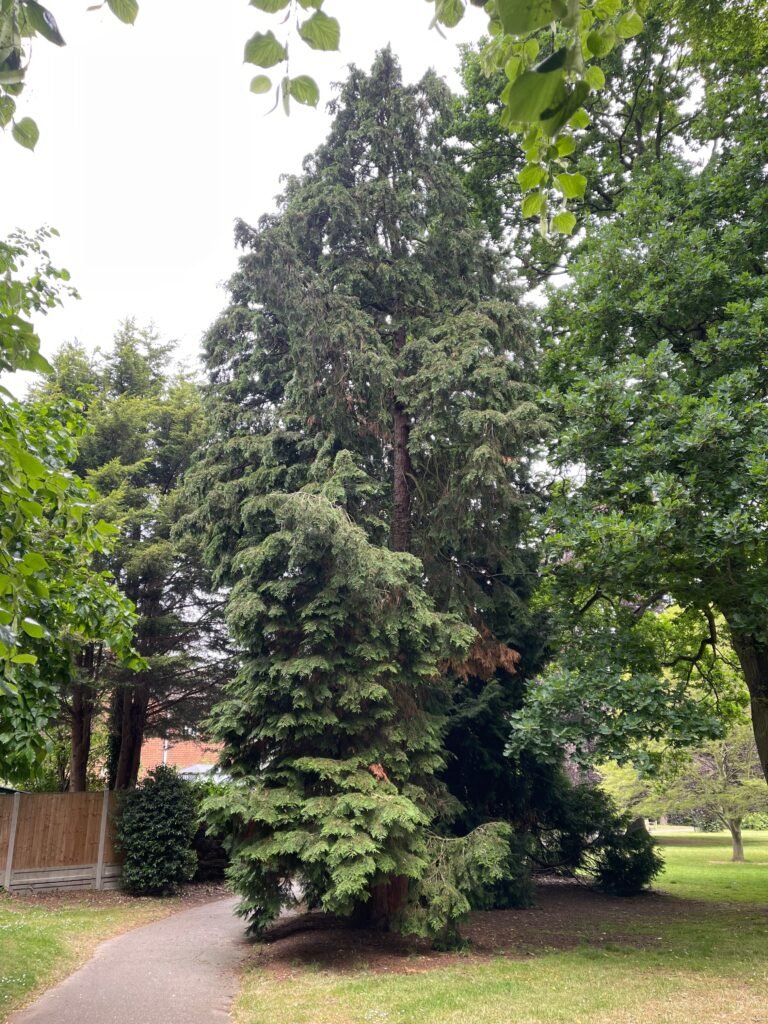Cypress, Lawson
The Lawson Cypress, is an evergreen conifer, that can grow to a height of 45m high, and may live more than 500 years.
A tall, narrowly conical tree, with feathery foliage. The bark is cracked into vertical plates, and the twigs are a dark bluish-grey.

Photo supplied by: Alan Payne
Common Name:
Lawson Cypress
Scentific Name:
Chamaecyparis lawsoniana
Tree No:
179
Location:
D4

Short scale-like leaves are grouped in fours and hide the twigs, forming flat planes. They are closely pressed together, producing flat sprays of foliage. They are green with a whitish tinge underneath. The foliage has a pungent scent, rather like parsley.

Credit: Alan Payne
Minute flowers, which look like buds, open at the twig tips in spring. Male flowers are crimson, becoming yellow with pollen, and females are blue.

Credit: This could be your image
Cones ripen from female flowers, starting green, then turning cream and finally ending brown. They are pea-sized with broad scales.

Credit: This could be your image
Lawson cypress is native to California and was introduced to Britain in 1854. There are now many ornamental cultivars. This evergreen tree is grown widely in parks, gardens and churchyards. It can regenerate from seed, and has naturalised on banks, walls and woodland margins throughout lowland UK. It grows best in moist but not waterlogged soils.
The dense foliage provides shelter for nesting birds, including various finches, when many broadleaved trees are still in bud.
The wood, which is strong and light, is highly valued in Japan for coffin and shrine construction. It is also used to make arrow shafts and musical instruments, especially guitars. It is grown widely in the UK as an ornamental tree.
Here is a good opportunity to tell the difference between the Lawson Cypress (Tree 179) and Western Red Cedar growing alongside it (Tree 180)
There are several Lawson Cypress as well as Western Red Cedars in the gardens see if you can tell them apart. Look at the cones. The Lawson Cypress cones open around a central point. On the underside of the foliage, they have a series of white crosses.
On the other side of the path close to the gate into St Peter’s Road from the right is a Cypress Macrocarpa Tree (Tree 173). This is a true Cypress not to be confused with the Lawson Cypress of which there are many in the gardens.
.
Tree Listings
Lucombe Oak
Oak, Lucombe The Lucombe Oak, is a large spreading semi-evergreen tree, that can grow to a height of over 20m, and may live for 240 years. The bark is thick and corky and is fire resistant. Branches on older trees can be quite chunky. The buds are brownish, ovate...
Holme Oak
Oak, Holme The Holm Oak, is a broadleaf evergreen tree, that can grow to a height of over 20m, and may live for 400 years. The crown is broad, domed, with ascending branches and often with low stems. The bark is black and finely cracked, and the twigs are slender and...
English Oak
Oak, English The English Oak, the majesty of the woods, is a broadleaved deciduous tree, that can grow to a height of 40m, and may live for 1,000 years. This species grows and matures to form a broad and spreading crown with sturdy branches beneath. Photo...
English Oak
Oak, English The English Oak, the majesty of the woods, is a broadleaved deciduous tree, that can grow to a height of 40m, and may live for 1,000 years. This species grows and matures to form a broad and spreading crown with sturdy branches beneath. This tree was...
Red Maple
Maple, Red The Red Maple, is a striking broadleaved deciduous tree, that can grow to a height of 20m, and may live for 200 years, although 80 to 100 years may be more typical. This tree was planted in memory of Mr Hungerford Rowley, a long and respected resident of...
Red Maple
Maple, Red The Red Maple, is a striking broadleaved deciduous tree, that can grow to a height of 20m, and may live for 200 years, although 80 to 100 years may be more typical. Photo supplied by: Alan PayneCommon Name:Red Maple Scentific Name:Acer rubrum Tree...
Norway Maple
Maple, Norway The Norway Maple, is a broadleaved deciduous tree, that can grow to a height of 25m, and may live for 150 years. The bark is grey with fine ridges, and the twigs are slender and brown with tiny white spots. Photo supplied by: Alan PayneCommon...
Norway Maple
Maple, Norway The Norway Maple, is a broadleaved deciduous tree, that can grow to a height of 25m, and may live for 150 years. The bark is grey with fine ridges, and the twigs are slender and brown with tiny white spots. Photo Supplied By: Alan PayneCommon...
Field Maple
Maple, Field The Field Maple, is a sturdy broadleaved deciduous tree, that can grow to a height of 20m, and may live for 350 years. The bark is light brown and flaky, and twigs are slender and brown and develop a corky bark with age. Small, grey leaf buds grow on long...
Common Lime
Lime, Common The Common Lime, a hybrid between small-leaved and large-leaved lime, is a broadleaved deciduous tree, that can grow to a height of 40m, and may live for 400 years. The bark is pale grey-brown and irregularly ridged, with characteristic large burrs and...
Horse Chestnut
Horse Chestnut The Horse Chestnut, with its shiny mahogany conkers, is a broadleaved deciduous tree, that can grow to a height of 40m, and may live for 300 years. The bark is smooth and pink-grey when young, which darkens and develops scaly plates with age. Twigs are...
English Elm
Elm, English The English Elm, is a deciduous tree, that can grow to a height of 30m, and may live more than 100 years. The bark is grey-brown, rough and fissured, often with suckers growing from the base of the trunk. The twigs are finely hairy. Photo supplied...
Braintree & Bocking Public Gardens,
43 Bocking End,
Braintree,
CM7 9AE.
Open 9:00 to 4:00pm – January, February.
Open 9:00 to 6:00pm – March.
Open 9:00 to 7:00pm – April.
Open 9:00 to 8:00pm – May, June, July, August.
Open 9:00 to 7:00pm – September.
Open 9:00 to 6:00pm – October.
Open 9:00 to 4:00pm – November December.
Note – The gates are locked at dusk.
Dusk is subject to seasonal variation, so closing times may not be exactly to the schedule, at the transitions.
No dogs allowed in the gardens.
No alcohol to be consumed in the gardens.
No riding of cycles or scooters in the gardens.
General Enquiries
Phone: 01376 773066
Email: info@braintreeandbockinggardens.co.uk
Tennis Enquiries
Phone: 01376 773070
Email: tennis@braintreeandbockinggardens.co.uk
© Braintree & Bocking Public Gardens Trust 2017-2021. All Rights Reserved.
Registered Charity Number 212989
Get in touch


Braintree and Bocking Public Gardens
We provide, maintain and preserve these unique and beautiful gardens as a community green space.